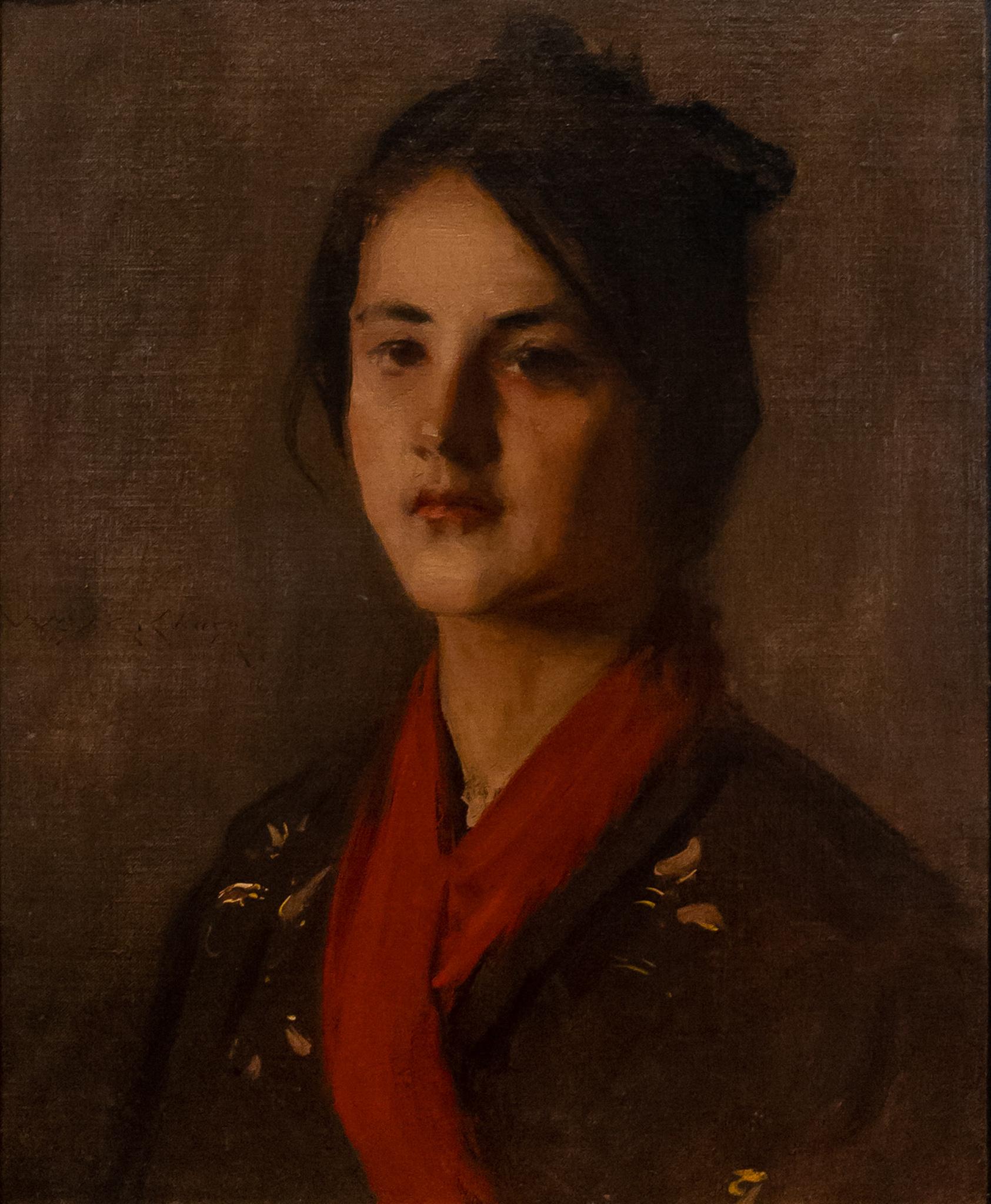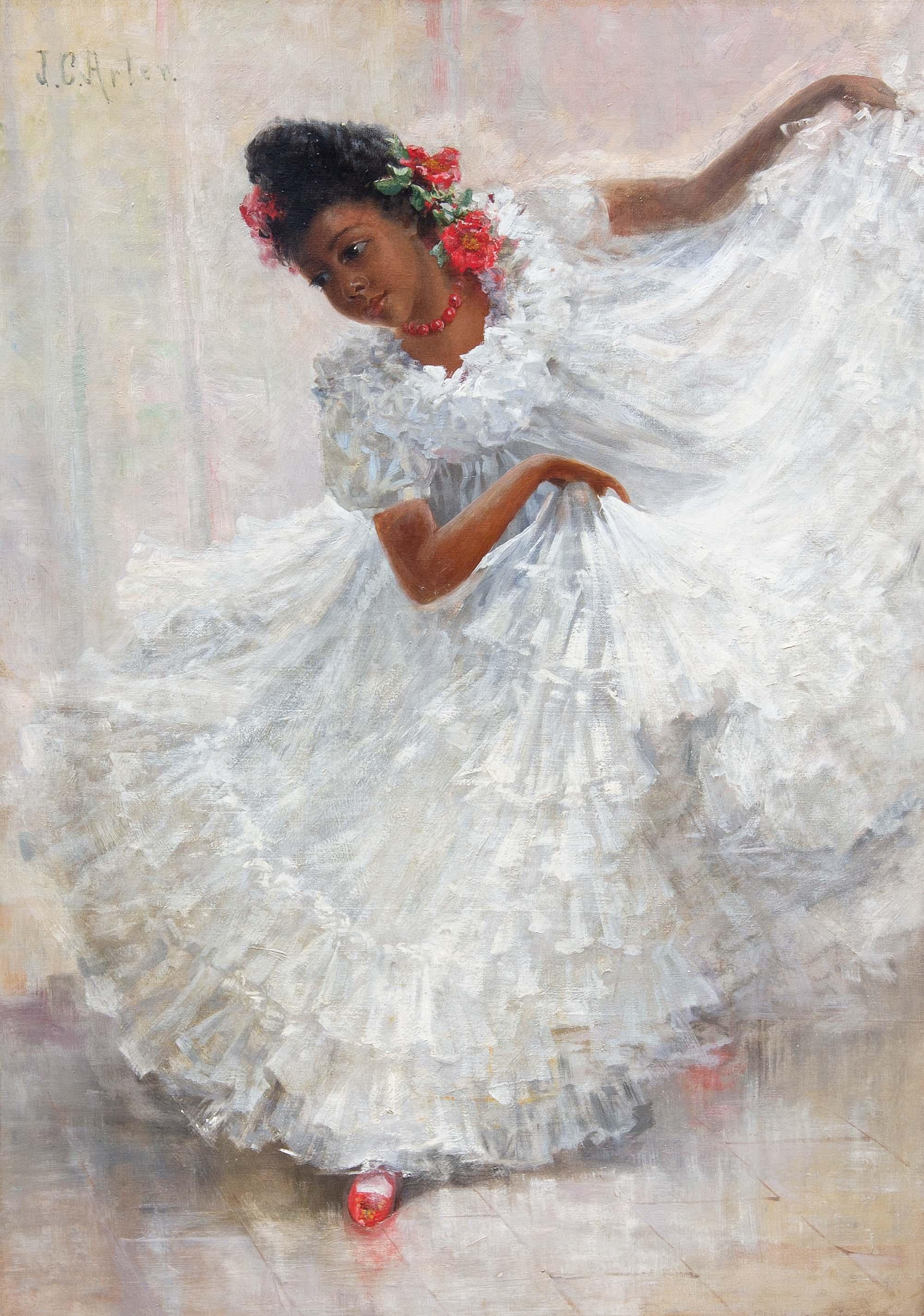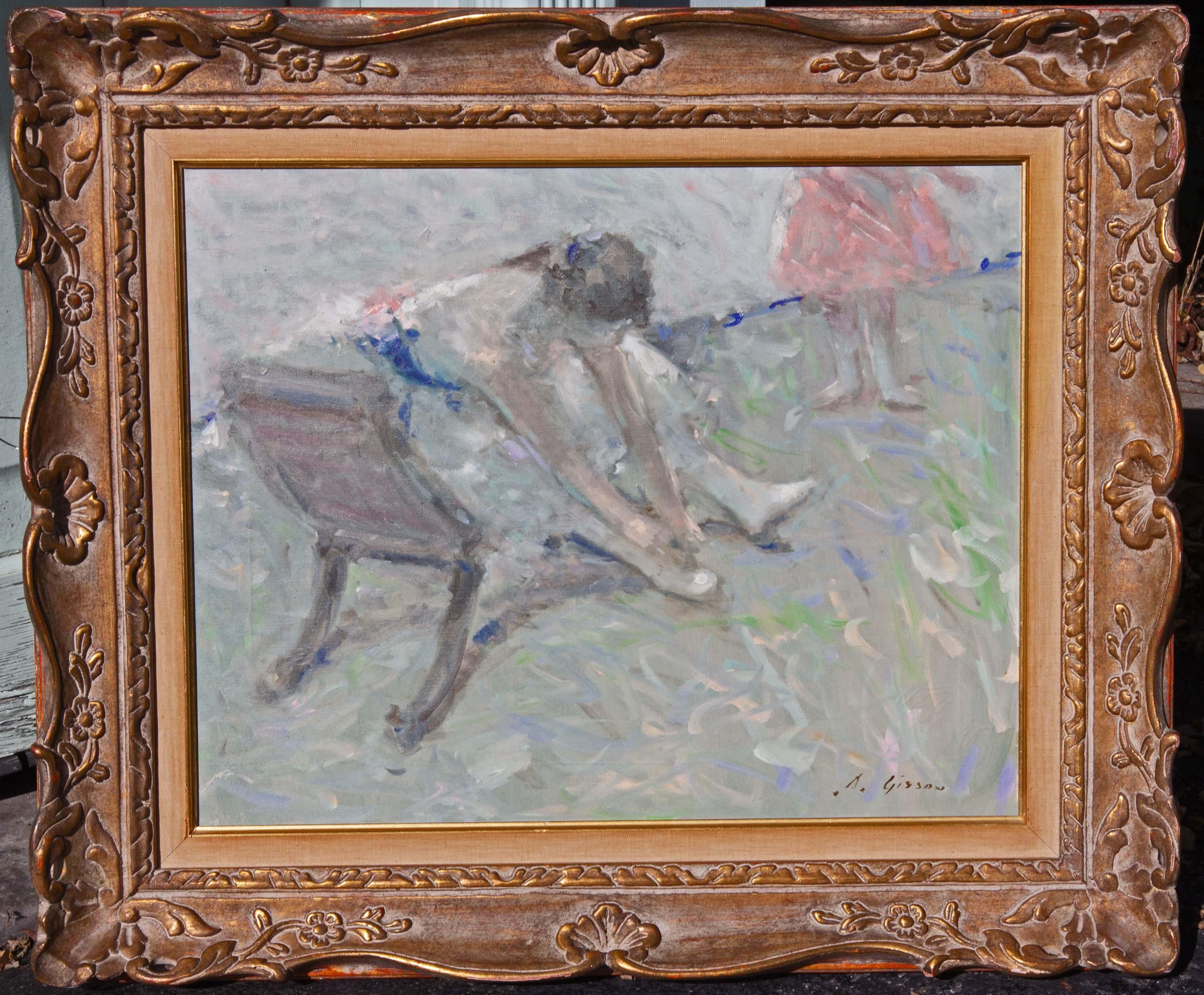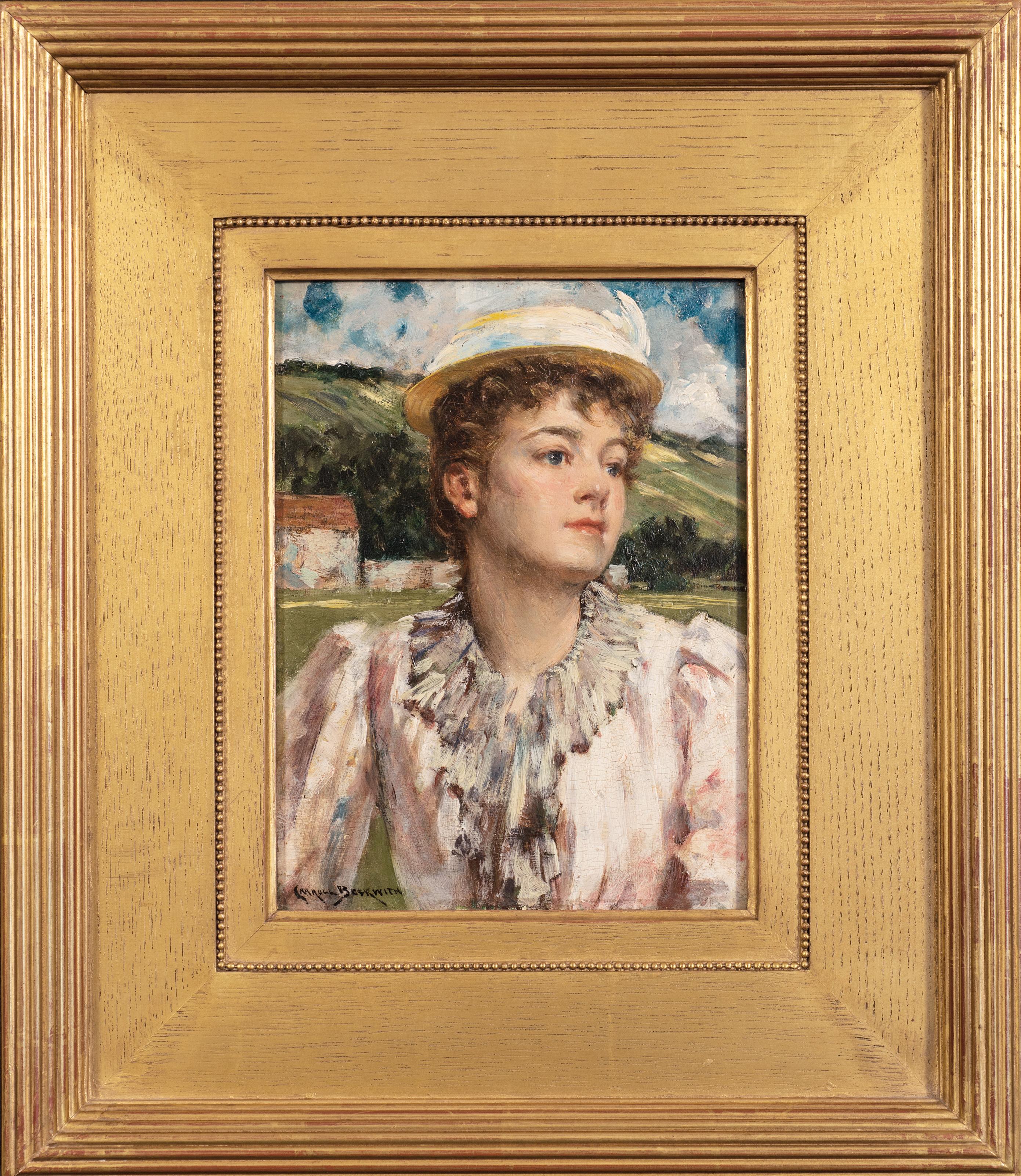Items Similar to Pauline - British 50s art Impressionist female portrait oil painting exhib. work
Want more images or videos?
Request additional images or videos from the seller
1 of 12
Bernard Fleetwood WalkerPauline - British 50s art Impressionist female portrait oil painting exhib. workcirca 1950
circa 1950
About the Item
Painted by the noted British Impressionist artist Bernard Fleetwood Walker, this fine oil on panel portrait depicts Pauline and was painted circa 1950. It was exhibited at The Royal Academy the same year. Housed in its original Bourlet exhibition frame, it is a fine example of his work.
Signed lower left.
Provenance. Exhibited Royal Academy 1950, Memorial Exhibition.
Bourlet frame and transportation label verso.
Condition. Oil painting on panel, 20 inches by 16 inches and in excellent condition.
Housed in its original exhibition Bourlet frame, 27 inches by 23 inches. In very good condition.
Bernard Fleetwood-Walker , PPRBSA, (1893-965) was an English artist and teacher of painting. Invariably known as B. Fleetwood-Walker, he was born in Birmingham, United Kingdom, a twin and one of five children. His father William Walker was an electrical engineer and co-inventor of the Walker-Wilkins battery, while his mother Electra Amelia (née Varley) was granddaughter of the 19th century watercolourist Cornelius Varley who, together with his brother John Varley, had been amongst the founder members of the Royal Watercolour Society in 1804. Fleetwood-Walker was educated at Barford Street School and at King Edward’s Grammar School, Five Ways and went on to train in the arts as a silver and goldsmith. Through working as a modeller and on low relief he developed an interest in painting and furthered his studies at the Birmingham School of Art and Crafts, as well as in London and under Fleury in Paris.
During the First World War he served in France as a sniper in the Artists Rifles and was wounded and gassed. Various studies exist showing he continued to draw while in the army and a fellow soldier, years later in a letter to the artist’s widow, described mural decorations he painted for Christmas 1918 on the wall of a warehouse being used as a mess-hall in the deserted village of Auberchicourt, near Douai. He used dry colours found in a builder’s yard mixed with ‘the glutinous substance you get from oatmeal porridge’. These materials were ‘food and drink to him’ and he regarded the war years as wasted time.
Returning to Birmingham after the war he married Marjorie White (‘Mickey’) in 1920 and had two sons, Colin and Guy. He taught, first at King Edward’s Grammar School, Aston where added to his talents he designed remarkably avant-garde scenery for the school plays, and then, from 1929 as a gifted, respected and influential lecturer at the Birmingham College of Art under Harold Holden. Having been trained at a time when strong drawing and a high level of technical skill was the pre-requisite of a successful career, he excelled as a draughtsman and through his teaching encouraged these virtues in others. He encouraged his students to use every sort of medium to hand, doled out fierce criticism and demanded high standards, and at the same time lectured perceptively on contemporary art movements. He worked prodigiously during this time, exhibiting at the Royal Academy from 1925, developing his abilities as a practising artist and quickly gaining a reputation not only as a painter of portraits and children but also for the large figurative paintings of the 1930s, many of which are now in public collections. He had a one-man exhibition at the Ruskin Gallery, Birmingham in 1927, but showed his work primarily at the societies to which he regularly sent his work. He was elected an Associate of the Royal Academy in 1946 and a Royal Academician in 1956 – showing a total of 147 works there over the years. He was a member of the Royal Society of Portrait Painters, the Royal Institute of Oil Painters and the New English Art Club. Always extremely loyal to his hometown, he declared he was proud to be the only Royal Academician from Birmingham who still lived and worked there, and was particularly pleased to have been elected President of the Royal Birmingham Society of Artists (RBSA) in 1950. In 1946 Fleetwood-Walker was elected to the Royal Watercolour Society consequently fulfilling the conditions of Cornelius Varley’s will – that the next artist in his family to be a member should inherit Varley’s studio collection. After his first wife died, he married Dr Peggy Frazer in 1939 and continued to work and teach in Birmingham through to 1956. Each year he would take a group of students from Birmingham to sketch in Cornwall and was a member of the St Ives Society of Artists (1936–1949). He also went on sketching tours on the continent and exhibited at the Paris Salon winning both bronze and silver medals. He finally moved to Chelsea so that he could devote more time to the students at the Royal Academy School where he was Assistant Keeper. He died in London on 30 January 1965. In the introductory essay of the catalogue to the Memorial Exhibition held at the RBSA in 1965, Richard Seddon described his work as follows: ‘He allowed his style to develop to the full and kept moving throughout his active life as an artist; and from the drawing and painting of a conceptual clarity based on his disciplined skill with line, he progressed to a visual intensity that synthesised light, space and tactile qualities as unified images laid on the canvas with a spontaneity and breadth unsurpassed by many of his British contemporaries.’
- Creator:Bernard Fleetwood Walker (1893 - 1965, British)
- Creation Year:circa 1950
- Dimensions:Height: 27 in (68.58 cm)Width: 23 in (58.42 cm)Depth: 2 in (5.08 cm)
- Medium:
- Movement & Style:
- Period:
- Condition:
- Gallery Location:London, GB
- Reference Number:1stDibs: LU853113392662
About the Seller
5.0
Platinum Seller
These expertly vetted sellers are 1stDibs' most experienced sellers and are rated highest by our customers.
1stDibs seller since 2018
398 sales on 1stDibs
Typical response time: <1 hour
- ShippingRetrieving quote...Ships From: London, United Kingdom
- Return PolicyA return for this item may be initiated within 14 days of delivery.
More From This SellerView All
- Portrait of Kitty and Silver Ship - British Edwardian Impressionist oil paintingBy James Jebusa ShannonLocated in London, GBThis stunning, large British Edwardian Impressionist portrait oil painting is by noted portrait painter James Jebusa Shannon. Painted circa 1909 the sitter is his eldest daughter, Kitty. She is holding a family heirloom, the silver ship which has been depicted in several of shannon's works. The painting of his daughter, just on the cusp of entering womanhood, was dear to the artist and stayed within the family long after his death. The vibrant reds and bold brushwork, so unmistakable Shannon, make this an excellent example of a very personal and precious Edwardian family portrait oil painting. Provenance. The Artist. Lady Florence Shannon. By descent to Kitty Shannon Keigwin, the Artist's daughter. By descent to Julia Gibbons, the Artist's granddaughter. Estate of Julia Gibbons to the present owner. Exhibited. "Seeking Beauty: Paintings by James Jebusa Shannon," Debra Force...Category
Early 1900s Impressionist Portrait Paintings
MaterialsOil
- Self Portrait in Studio - British art 19th Century interior oil paintingLocated in London, GBA fine interior oil painting which dates to circa 1870 by listed artist Alfred Stevens. It is a superb British Impressionist painting which depicts the artist in his studio in front ...Category
19th Century Impressionist Portrait Paintings
MaterialsOil
- Girl in Pink - Scottish 1920's Impressionist art female portrait oil paintingLocated in London, GBThis lovely Scottish Colourist portrait oil painting is by noted Scottish female artist Helen Ainslie Wingate. She was the daughter of Sir Charles Lawton Wingate who was president of...Category
1920s Impressionist Portrait Paintings
MaterialsOil
- The Party Frock - British 1940's art female child portrait oil painting exhib RABy Dod ProcterLocated in London, GBThis charming British portrait oil painting is by female artist Dod Procter. It was painted in 1949 and exhibited at the Royal Academy London the same year. The painting is of a litt...Category
1940s Impressionist Portrait Paintings
MaterialsOil
- At the Foot of the Statue - Scottish art Impressionist figurative oil paintingBy William Strang, R.A., R.E.Located in London, GBA fine large oil painting by Scottish listed artist William Strang. This is a super evocative oil on canvas which depicts a family at "The Foot of the Statue". It was exhibited in 1904 in Bradford exhibition of fine arts lent by L W Hodson of Wolverhampton who was a patron of his work. This is a fine example of an early 20th century Scottish oil with good subject. It is a good size and signed. This wouldn't be out of place in Kelvingrove Gallery in Glasgow. Signed lower left. Provenance. Bradford Art Gallery 1904. Sotheby 19th June 2002 Guide price £20000-30000GBP. Condition. Oil on canvas. Image size 30 inches by 25 inches and in excellent condition. Housed in a fine period frame, 39 by 34 inches framed and in good condition. William Strang (1859-1921) was born at Dumbarton, the son of Peter Strang, builder, and educated at the Dumbarton Academy. He worked for fifteen months in the counting-house of a firm of shipbuilders before going to London in 1875 when he was sixteen. There he studied art under Alphonse Legros at the Slade School for six years. Strang became assistant master in the etching class, and had great success as an etcher. He was one of the original members of the Royal Society of Painter-Etchers, and his work was a part of their first exhibition in 1881. Some of his early plates were published in The Portfolio and other art magazines. He worked in many manners, etching, dry point, mezzotint, sand-ground mezzotint, and burin engraving. Lithography and wood-cutting were also used by him to create pictures. He cut a large wood engraving of a man ploughing, later published by the Art for Schools Association. A privately produced catalogue of his engraved work contained more than three hundred items. Amongst his earlier works were Tinkers, St. Jerome, A Woman Washing Her Feet, An Old Book-stall with a Man Lighting His Pipe from a Flare, and The Head of a Peasant Woman on sand-ground mezzotint. Later plates such as Hunger, The Bachelor's End and The Salvation Army were also important. Some of his best etchings were done as series—one of the earliest, illustrating poet William Nicholson's Ballad of Aken Drum, is remarkable for clear, delicate workmanship in the shadow tones, showing great skill and power over his materials, and for strong drawing. Another praised series was The Pilgrim's Progress, revealing austere sympathy with John Bunyan's teaching. Samuel Taylor Coleridge's Ancient Mariner and Strang's own Allegory of Death and The Plowman's Wife, have served him with suitable imaginative subjects. Some of Rudyard Kipling's stories were also illustrated by him, and his likeness of Kipling was one of his most successful portrait plates. Other etched portraits included those of Ernest Sichel and of J.B. Clark, with whom Strang collaborated in illustrating Baron Munchausen...Category
Early 1900s Impressionist Figurative Paintings
MaterialsOil
- Two Women in a Cafe - British 1930's art oil portrait painting Spain jugs pinkBy Darsie JappLocated in London, GBAn original oil on canvas by the British listed artist Darsie Japp. It was painted circa 1930 and depicts two woman at a table having a drink. A very evocative inter war oil painting...Category
1910s Impressionist Figurative Paintings
MaterialsOil
You May Also Like
- VAN BIESBROECK Jules. Portrait of a man . Oil sketch on cardboard. Unsigned.By Jules Pierre van BiesbroeckLocated in Paris, FRPortrait of a man. Oil sketch on cardboard. Unsigned. This work will be recorded in the catalogue raisonné of the work of the artist currently in preparation. Jules Van Biesbroeck was the son of Jules Evariste van Biesbroeck, a painter of Ghent, but was born in Italy, in Portici, near Naples, while his parents were staying there. (In the 19th century many artists made educational trips to Italy). It was a long visit: the child was two years old by the time the family returned to Ghent.[1] After a short period of practice with his father, van Biesbroeck was enrolled in the Academy of Fine Arts in Ghent. His first painting, "The Shepherd" (French: Le pâtre), was sold at the Triennale in Ghent. In 1888, when he was only 15 years old, he made his debut at the "Salon des Champs-Elysées" in Paris with his monumental work "The Launch of the Argo" (French: Le lancement...Category
Early 20th Century Impressionist Portrait Paintings
MaterialsOil
- The Gray KimonoBy William Merritt ChaseLocated in New York, NYThe Gray Kimono, 1901, by William Merritt Chase (1849-1916) Oil on canvas 20 x 16 inches unframed (50.8 x 40.64 cm) 28 x 24 1/16 inches framed (71.12 x 61.11875 cm) Paper (Alice Wil...Category
Early 20th Century American Impressionist Portrait Paintings
MaterialsOil
- Impressionist Painting "Ballerina" by Andre GissonBy André GissonLocated in Rochester, NY"Ballerinas" impressionist painting by Andre Gisson (1921-2003). Soft colors and bright light are hallmarks of Gisson's work. This is rare subject manor for the artist. Although Am...Category
20th Century Impressionist Figurative Paintings
MaterialsFabric, Oil, Wood, Canvas
- Impressionist Painting of a Young Spanish Flamenco Dancer by J.C. ArterBy John Charles ArterLocated in Rochester, NYWonderful impressionist painting. Full of light, color, and movement. "The Flamenco Dancer by J. Charles Arter ( American 1860-1923). Oil on canvas. Signed upper left. Circa 1900. Unframed. Born in Hanoverton, Ohio, Charles Arter studied in Cincinnati and Paris at the Academie Julian. He had studios in Venice, London and New York and painted portraits of many famous personages including Pope Pius X...Category
Early 20th Century Impressionist Figurative Paintings
MaterialsOil, Canvas
- Impressionist Painting of a Bohemian Woman Budapest 1925 Bertha De HellebranthLocated in Rochester, NYBohemian woman Budapest, Hungary 1925 by Bertha De Hellebranth. Fabulous period painting brings to life the bohemian intelligentsia of Europe in the 1920's. I believe the painting is of the artists sister Elena Maria De Hellebranth. Both sisters were accomplished artist and worked and exhibited together. See the photo of the sisters Elena on the left and Bertha on the right. Oil on canvas. In a period frame. Signed lower right. Inscribed on reverse. Provenance: label from Newman Galleries Philadelphia. BIOGRAPHY ; Bertha de Hellebranth and her sister Elena were born into a cultured upper-class family in Budapest, Bertha in 1899, Elena in 1897. Their father was a lawyer and their mother a student of Franz Liszt's last living pupil. Both sisters showed artistic potential early, beginning to paint at four or five years of age. Their parents encouraged them, and had the means to send them to the best art schools of the time. They studied at the Academy of Fine Art in Budapest, at the Académie Julian and the Académie de la Grande Chaumière in Paris, and painted portraits of European nobility. As Patricia Fazekas points out, "Growing up in a family of privilege, they seemed to have unusual access to many illustrious people." So we should not be surprised to find among their subjects members of high society, such as Count Andrássy Gyula, the Russian-born Princess Baby Galitzine, and Admiral Horthy Miklós, the Regent. Later on, their subjects included American heiress Gladys Vanderbilt (Countess László Széchenyi), President Theodore Roosevelt's granddaughter Paulina Longworth and former President Dwight D. Eisenhower.Often, the sisters would paint the same subject at the same time, offering the sitter a choice of portraits. Most often, the sitter wanted both renditions.While Elena concentrated on working in oil and watercolor, Bertha used gouache and oil to achieve her effects. Elena gave lectures and workshops, was a writer and also wrote popular and ecclesiastical music, while Bertha also went in for sculpture and handicrafts.From the mid-thirties until World War II, Bertha and Elena divided their time between their home in Budapest and a home on the ocean at Ventnor, NJ. In 1925, they showed their work at the Nemzeti Szalon in Budapest, and in 1926, they had a joint exhibition of their portraits in the US. Both exhibited their work at the Art Institute of Chicago, the Brooklyn Museum of Art, the Pennsylvania Academy of Fine Arts and most major museums and galleries in the US. Bertha also had exhibits at the Metropolitan Museum of Art. Both Bertha and Elena were Fellows of the Royal Society of Art (London), and garnered numerous prizes. Bertha was awarded First Prize by the National Academy of the American Water Color Society one year, and the Grand Prize of the Audubon Society. She was one of the founders of the now defunct World League of Hungarian Artists Abroad (Külföldi Magyar Képz?m?vészek Világszövetsége), and received a Gold Medal from the Cleveland Árpád Akadémia in 1963. (Elena also received the Akadémia's gold medal in 1965.) Their work is found in museums and galleries too numerous to mention.The de Hellebranth sisters were devout Catholics, and this is evident in their many portraits of clerics...Category
Early 20th Century Impressionist Figurative Paintings
MaterialsCanvas, Fabric, Oil
- NitaBy James Carroll BeckwithLocated in New York, NYJAMES CARROLL BECKWITH (1852-1917) Nita Oil on panel 10 1/16 x 7 5/8 inches Signed lower right Inscribed, “Background of/Nita Sewell/1897,” verso James Carroll Beckwith enjoyed enor...Category
Late 19th Century American Impressionist Portrait Paintings
MaterialsOil, Panel




